BtC Project: Public health messages via smartphone
The text messaging/mobile video campaign promotes education on contraceptive options to the pill
“Get reliable. Get forgettable. Get low cost… Get a new method.” That’s a key message of a new USF-directed mobile phone campaign that aims to educate college students about long-acting, reversible contraceptives (LARCs), which are highly effective in preventing unintended pregnancy but do not require daily user attention and can often cost less than birth control pills.
The pilot project, known as Beyond the Condom, or BtC, is funded by a grant to USF College of Public Health researcher Eric Buhi, PhD, by the National Campaign to Prevent Teen and Unplanned Pregnancy. BtC (text “BTC” to 99222) was launched across the USF campus Sept. 28.
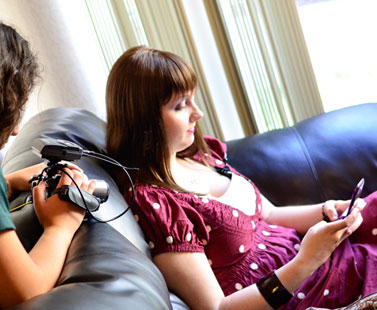
Videographer Amy Mariani gets some B-roll of USF undergraduate student Amanda Buck using her smartphone between takes.
BtC involved scripting and developing text messages and mobile videos intended to influence attitudes and behaviors about LARCs – intrauterine devices (IUDs), the implant, the shot, the ring, and the patch.
The project was closely coordinated with a university-community advisory board that included undergraduate students who helped the project team frame the messages. Health care professionals vetted the scripts for the medical accuracy of pros and cons about each LARC featured. USF students enrolled in sex, health and decision making classes provided feedback on the usability and acceptability of the text messages and mobile videos.
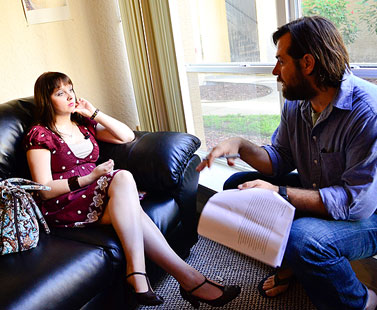
BtC production manager Ryan Morris discusses the video script with Buck.
“This project is different because it’s the first of its kind to study how mobile text and video can be used to promote contraceptive use behavior change, “said Buhi, whose research focuses on the impact of technology and social media on the sexual health and experiences of adolescents and young adults. “ It gives young women an opportunity to text in to learn more about these long-acting, reversible birth control methods in a way that’s convenient for them and very private.
“We’re capitalizing on the mobile technologies young people use in every aspect of their lives today to get across our public health messages.”
As an added benefit to texting in, Buhi said, women are able to access a database, which helps identify LARC-friendly health providers in their area when the user types in her zip code.
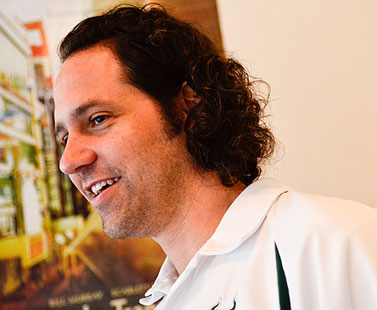
USF College of Public Health researcher Eric Buhi, PhD, led the pilot project, which capitalizes on smartphone technology widely used by college students.
This spring and summer, a production team of students and staff led by Buhi, spent several days filming six mobile videos at various locations around USF, including a student’s apartment near the campus, in the USF Library, at the Marshall Center and at Student Health Services. All the young women in the 2-minute conversational videos were USF students, including Amanda Buck.
“I think it’s important for college women to know about birth control options other than the pill, which they may forget to take at the same time every day,” said Buck, an undergraduate theater major who appears in the video about the patch.

The BtC production crew
The majority of college-age women who use contraceptive (65 percent) are on the pill, despite the increasing variety of LARCs that are “remarkably easy to use, safe and effective in preventing pregnancy,” said Tricia Trow Weaver, assistant director of the Women’s Health Clinic, USF Student Health Services.
Weaver, a physician’s assistant, appears in the mobile video offering suggestions on what to consider when discussing birth control options with your healthcare provider, including lifestyle, effectiveness, cost, potential side effects and how long you want the method to last. She emphasizes a message repeated throughout the BtC campaign — whatever contraceptive method is chosen to prevent pregnancy, condoms are still important for protecting against sexually transmitted diseases.
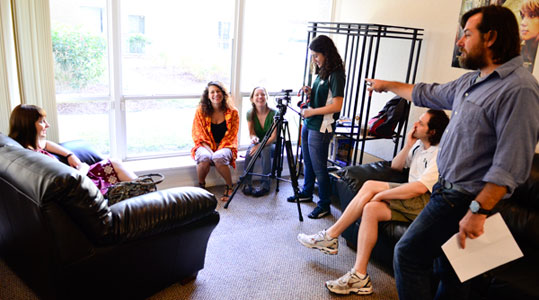
Weaver said she was fascinated by the opportunity to be part of a sexual health campaign that tapped into smartphone technology. “If you’re targeting a college student population, it’s certainly a way to get their attention,” she said. “I can be doing a Pap smear for a young woman, and she’s texting on the phone.”
The campus-wide marketing campaign promoting BtC includes a Facebook page, flyers, T-shirt giveaways and advertisements in dormitories, on the Bull Runners and displayed on the video monitors in the Marshall Student Center.

Buhi speaks to a student while handing out pens as part of the grass-roots promotional campaign launching the BtC project.
Buhi, assistant professor of community and family health, will analyze the outcome of the project, including how many people accessed the mobile application and opted to watch the videos. If it proves effective in reaching USF students, BtC may be expanded to other college campuses across the state, he said.
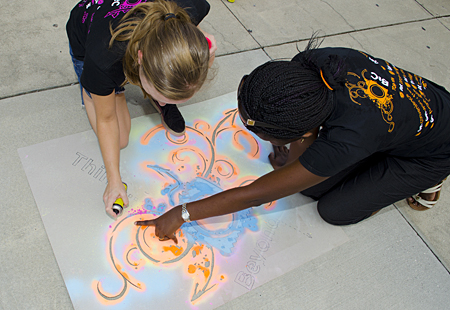

MPH students Natalie Rella, left, and Joke Ogunrinde use aerosol chalk to stencil the BtC logo on sidewalk outside the USF Marshall Student Center.
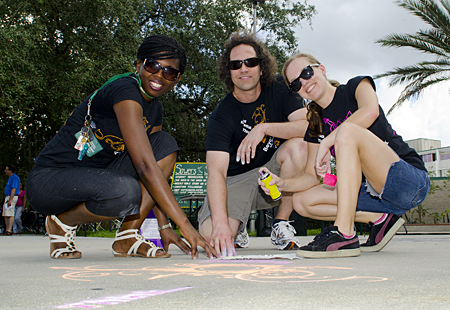
L to R: Ogunrinde, Buhi and Rella

Story by Anne DeLotto Baier, and photos by Eric Younghans, USF Health Communications

